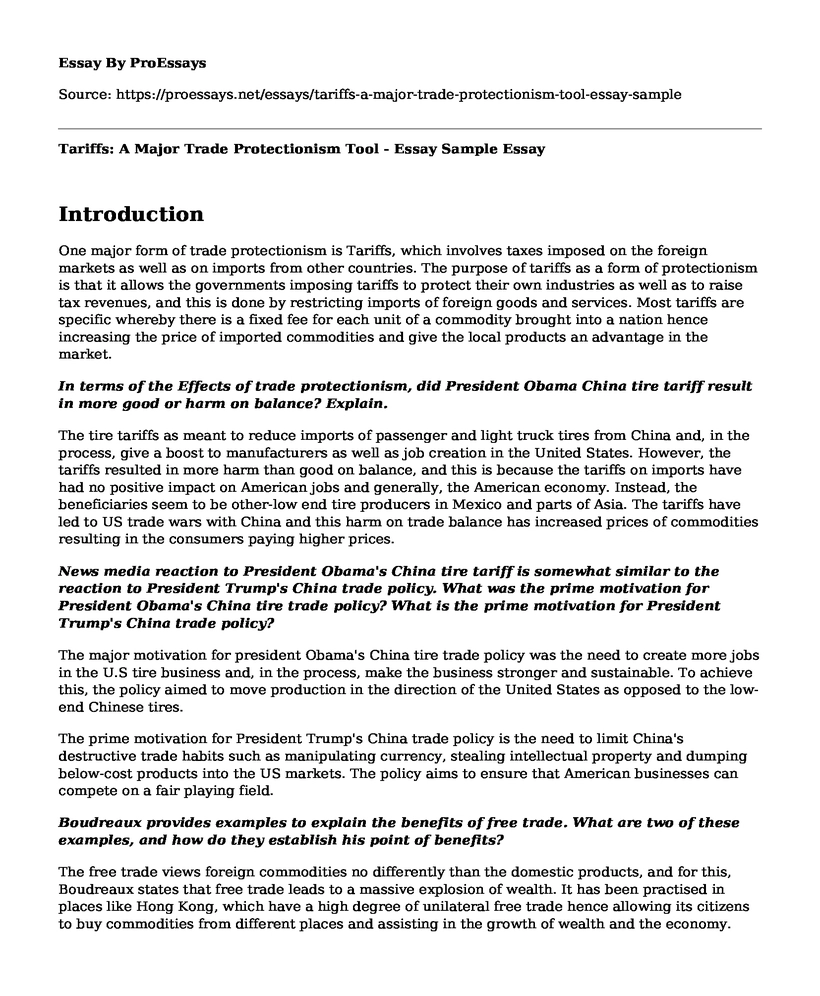Introduction
One major form of trade protectionism is Tariffs, which involves taxes imposed on the foreign markets as well as on imports from other countries. The purpose of tariffs as a form of protectionism is that it allows the governments imposing tariffs to protect their own industries as well as to raise tax revenues, and this is done by restricting imports of foreign goods and services. Most tariffs are specific whereby there is a fixed fee for each unit of a commodity brought into a nation hence increasing the price of imported commodities and give the local products an advantage in the market.
In terms of the Effects of trade protectionism, did President Obama China tire tariff result in more good or harm on balance? Explain.
The tire tariffs as meant to reduce imports of passenger and light truck tires from China and, in the process, give a boost to manufacturers as well as job creation in the United States. However, the tariffs resulted in more harm than good on balance, and this is because the tariffs on imports have had no positive impact on American jobs and generally, the American economy. Instead, the beneficiaries seem to be other-low end tire producers in Mexico and parts of Asia. The tariffs have led to US trade wars with China and this harm on trade balance has increased prices of commodities resulting in the consumers paying higher prices.
News media reaction to President Obama's China tire tariff is somewhat similar to the reaction to President Trump's China trade policy. What was the prime motivation for President Obama's China tire trade policy? What is the prime motivation for President Trump's China trade policy?
The major motivation for president Obama's China tire trade policy was the need to create more jobs in the U.S tire business and, in the process, make the business stronger and sustainable. To achieve this, the policy aimed to move production in the direction of the United States as opposed to the low-end Chinese tires.
The prime motivation for President Trump's China trade policy is the need to limit China's destructive trade habits such as manipulating currency, stealing intellectual property and dumping below-cost products into the US markets. The policy aims to ensure that American businesses can compete on a fair playing field.
Boudreaux provides examples to explain the benefits of free trade. What are two of these examples, and how do they establish his point of benefits?
The free trade views foreign commodities no differently than the domestic products, and for this, Boudreaux states that free trade leads to a massive explosion of wealth. It has been practised in places like Hong Kong, which have a high degree of unilateral free trade hence allowing its citizens to buy commodities from different places and assisting in the growth of wealth and the economy. Moreover, free trade allows for the availability of lower-cost goods and services to the consumers because the little restriction on trade allows for a relatively high exchange of commodities leading to variety, low costs and availability.
Norberg states that "If the trade is exploitation, then the problem in the world is most people aren't sufficiently exploited." Explain how he justifies this position.
Norberg argues his position that the poor who seem exploited tend to want the businesses to expand in order to create more jobs for their relatives; this is because they make comparison with other agricultural-based sources of income and working in industries seems better. Free trade helps poor people because children, for example, have always worked in terrible conditions, globalization has only worked to make the world more aware of this. Therefore if the trade is exploitative, then this exploitation also gives leverage to the poor and gives them a chance to escape poverty.
Arrunga relates that Kenya was known as having high tariff barriers, but that has changed. How does she explain that Kenya's liberalization of trade has made Kenya's poorer people better off?
Arrunga states that liberalization of trade in Kenya has increased trade, making it possible for poor people to engage in income-generating activities such as importation of affordable commodities from China. Some benefits include a rise in mobile phone usage from 300,000 to over ten million in a period of ten years and it is the poor people who benefit the most.
Cite this page
Tariffs: A Major Trade Protectionism Tool - Essay Sample. (2023, Mar 27). Retrieved from https://proessays.net/essays/tariffs-a-major-trade-protectionism-tool-essay-sample
If you are the original author of this essay and no longer wish to have it published on the ProEssays website, please click below to request its removal:
- Course Work Sample: Performance of Hospital Organization and Budget
- Essay Sample on Derivatives Options and Swaps
- Arguments for the High Price of Tesla Stock Essay
- Changes Made by TCJA Relating to Income Tax Rate for Individuals Essay
- Tesco Case Study
- Essay Example on Purple Cloud: Economic Woes and Viable Solutions
- Unlocking the Potential of Technology Scanning: A Strategic Investment for Business - Essay sample







